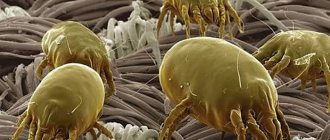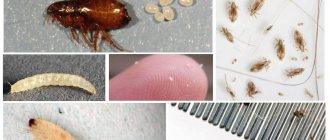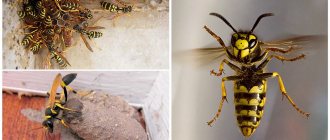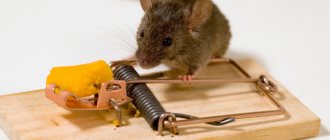Methods for controlling ferrets and weasels
The following methods will help save chickens:
- Traps;
- Electronic repellers;
- Traditional methods;
- A trap made from improvised means.
Trap
For such cautious animals as ferrets and weasels, one trap will not be enough. You will need several traps, because these animals know how to deftly bypass them. Feathers or a chicken carcass will help reduce the vigilance of predators.
Bait is placed in one of the traps, and several more traps are placed along the way to it. Smart animals will bypass all the traps, grab the prey in a trap with bait and begin to back away. At this moment the trap will work. The method, of course, is not the most humane, but the most effective of all existing ones.
Traps must be installed in compliance with certain rules:
- Use gloves and do not touch the trap with bare hands, as animals will immediately smell a person and will not approach the traps;
- Place traps in different places each time, as predators constantly change their hunting routes.
Repellers
Unlike traps, this method is more humane. You won't be able to kill a ferret using a repeller, but you can stop the predators' interest in the house. The operation of electronic devices is based on low frequency pulses. In animals they arouse feelings of anxiety and panic. Naturally, the predator will leave the dangerous place.
A successful alternative to an electronic repeller would be a flashlight equipped with a motion sensor. Install a light fixture with a sensor in the coop. When a weasel or ferret appears, it will give sound and light signals that will scare the animals away.
Folk remedies
Farming practice is rich in effective methods of scaring away small predators from poultry houses. One of these methods is the use of tar; it is used to treat walls in poultry houses. To enhance the effect of tar, undressed sheep or goat skins are hung in the chicken coop. The persistent animal smell can scare away predators of the mustelid genus.
For the same purpose, a dog house is installed near the chicken coop. Small animals are not afraid of dogs, but the smell of a dog and loud barking can discourage you from visiting the chicken coop.
Please note that predators of the mustelid family do not tolerate strong odors and loud sounds, and also react to flashes of light at night. Use these features to protect your poultry
A trap made from improvised means
You can try to catch small pests with your bare hands, although this is quite difficult. Equip yourself with patience, a thick blanket and thick gloves, and then settle into the coop for the night.
When a predator appears, throw a blanket over it to keep it down and then place it in its cage.
You will need protection for your hands, because the animal is resourceful, has sharp claws and equally sharp teeth. If a ferret or weasel nevertheless managed to bite the hand, pinch the animal’s nasal passages, and when it opens its jaw a little, insert a piece of wood and free the hand. Be prepared that during the operation the animal will emit unpleasant odors from the glands located in the anal area.
You can build a trap yourself from an ordinary bucket or a strong box. The bucket or box is placed on its edge and supported with a stick for support. Bait is placed under a bucket or box - feathers or a chicken carcass. Interest in the bait will force the uninvited guest to approach, the stop will fall, and the animal will be locked up.
Rats
Who strangles chickens at night? More precisely, chickens and very young birds? It could be rats.
Quite rarely, rodents attack poultry. Hunger forces them to do this. These animals are extremely smart, and in a moment of danger they are able to rush at a person, defending their own lives.
How to protect chickens from them? Set traps for rats. If you are lucky enough to find a nest or hole in the chicken coop, you can use the old method. Break the glass bottle so that the neck remains intact. Champagne bottles are best; they have thicker glass. The sharp edges are pushed forward into the holes. The rat will cut itself on it and return to its place of residence. And there her relatives will finish her off.
Disturb the nest, get rid of the baby rats, if they are there. And with the mother rat, do as described above.
How to understand that “thieves” are visiting you
Changes in chicken behavior
Ferrets, martens, and weasels visit poultry houses at night or at dawn. Therefore, it is difficult to catch them at the crime scene.
Predators do not always attack immediately. Often they first reconnoiter the situation. And at first you will not find obvious signs of their presence in the form of dead chickens.
You should be wary if you go into the chicken coop in the morning, and the birds are sitting on a perch or in nests and are not in a hurry to eat. This means that a ferret, marten or weasel definitely visited them at night.
The chickens are scared and worried. And they try to protect themselves and the masonry
And in order not to attract the attention of predators, they do not make a sound
True signs
If you don't take action, you will soon find a chicken with its head chewed off. This is exactly what predators do.
The ferret does not eat the head, only chews it off. But it leaves the carcasses in such a state that they cannot be used later in cooking. The marten prefers to steal chickens rather than eat on the spot.
Broken eggs are also a sign of uninvited guests. If you find that the contents of the testicles have been eaten, and the chickens are fine, most likely small rodents were operating in the poultry house. They are described in detail in the article “How to get rid of rats in a chicken coop.”
To understand who is strangling the chickens, measure the distance between the tracks of the animal: 40-45 cm - ferret, 20 cm - weasel, 30-35 cm - marten.
Animal habits
Neither a ferret nor a weasel will limit itself to one bird. If an animal has strangled a chicken at least once, it will visit the farm until it kills all the chickens, ducks and even geese.
Moreover, predators will remember the place. And if you start a new livestock, they will come again. Therefore, you need to know how to catch a weasel, ferret or marten. And not just drive away.
Animals get into the chicken coop by digging. Then they catch the bird, strangle it, and rip its throat out. The predator eats only one carcass at a time. But it is capable of killing up to two dozen birds.
The animals also travel along mouse and rat passages. And, of course, cracks in the walls, floors, rotten boards are almost an invitation for a weasel, marten or ferret.
Use of pets
If a ferret has already gotten into the habit of entering your chicken coop, then, sadly, the animal must be caught.
Pets - cats, dogs - help many farmers by protecting chicken coops from ferrets. They scare away predators, making it difficult to calmly hunt the bird.
The ferret is an active, cautious animal, so it is difficult to catch the enemy of poultry birds, but some pets are valuable hunters. Agile dogs and cats are capable of unexpectedly grabbing and crushing a ferret, weasel, or marten.
Important! Pets that hunt predators must be vaccinated against rabies.
Ferrets and other breeds of domestic ferrets are useful to farmers. They catch rodents by driving wild polecats out of their territory. Well-fed pets do not hunt birds. You should not allow tame ferrets only to the chicks: the chicks will turn out to be a toy for hunting and entertainment.
How to get rid of a ferret in a chicken coop
It is difficult to discourage a ferret from constantly receiving food. The predator will perceive any measures you take to combat it as obstacles and easily overcome them.
- remove garbage from the yard (boards, boxes);
- repair the chicken coop;
- get a dog;
- Close all openings into the poultry house firmly at night.
How to catch
Since the animal hunts only at night, catching it will not be easy, but possible.
There are several ways to catch a predator:
- use a dog;
- set a trap;
- catch by hand;
- build a live trap.
Using a trap
In order to catch a ferret in a trap, you need to place bait in it: it can be feathers or a chicken previously strangled by the animal. An effective way is not to place the carcass in a trap, but to hang it above the trap, which will disperse the predator. Thus, he will fall into the trap faster. Here it should be said that the trap should not have a human smell. Having smelled it, the predator will not climb into the trap.
There are several methods for eliminating odor:
- lubricate the trap with lime;
- rub with a solution of boiled spruce;
- treat with manure.
Move the trap after wearing thick gloves.
Using live traps
You can also catch a predator using a live trap. To build it yourself, you will need the following materials and tools:
- metal grid;
- welding machine;
- metal fittings;
- pin;
- spring;
- loops;
- bait board.
- Using a welding machine, weld a frame for the trap from metal reinforcement.
- Install a door and a mechanism that will be activated when a predator stands on the board where the bait is located. This will close the entrance and the animal will remain inside.
- Cover the frame with metal mesh on all sides.
- The trap is ready, install it in the chicken coop.
How to scare away
If you don’t want to use radical methods in the fight against a ferret, then you can resort to methods of scaring the animal away. Let's take a closer look at them.
Modern technical means
There are modern means of repelling various predators. They can be purchased in specialized stores.
There are two types of repellers:
- Light and sound. When a predator approaches the chicken coop, the repeller beeps and starts flashing red, which scares the animal away. This device runs on batteries or mains power.
- Ultrasonic. They emit ultrasonic waves that repel not only ferrets, but also mice, rats, and moles. Do not harm pets or humans. They operate using a battery or mains power.
Using Pets
Pets can also deter predators from hunting chickens. If you have a dog, move its kennel closer to the chicken coop. The ideal option would be to place the booth right next to the doors of the poultry house. Of course, not every dog is capable of catching a dexterous animal, but it will be able to notify you of an uninvited night guest by barking.
You can also use a domestic cat, which should be locked in a chicken coop at night, but do not forget that the ferret is a cunning and aggressive animal, so the cat may suffer from its paws. In addition, there is no guarantee that your pet will not want to eat homemade crusts while in close proximity to them.
Traditional methods
One of the popular folk ways to keep a ferret away from the chicken coop is to paint the outside walls of the poultry house with tar. However, this will not help if the house is not on a foundation, since the animal can dig a passage under the floor. You can also hang goat skin on the walls of the chicken coop; its smell will scare off predators.
What traps to use
To catch ferrets, traps of different models are used. Given the nocturnal lifestyle of the predator, the trap is set in the evening. Using traps, they ensure the safety of chickens: they place the traps in a place inaccessible to the birds.
After installation, traps must be treated with a special compound that repels the human odor that frightens predators.
They use a product sold in specialized stores, manure (the trap is coated with the substance), slaked lime (applied with a brush). If the location of the ferret's hole is known, a trap is placed nearby.
Read also: How to make a man guilty?
To catch a predator, they use the so-called. trap No. 1. The device's guard is made especially sensitive. The bait is a bird killed by a polecat, and the animal's blood is poured into the trap.
A rat trap that is strong enough to hold a large rodent is a suitable trap for a ferret. The device is additionally weighted by attaching it to a large board to make the trap stable.
The ferret overturns a light rat trap, vigorously escaping. The freed predator, remembering the dangerous trap, always bypasses the rat traps.
What to do?
Get rid of the visitor. In addition to damaging the farm, the fox also spreads rabies. A sick predator can attack a person. Therefore, having barely noticed fox tracks, it is necessary to urgently take action.
The best way to get rid of the red cheater is a live trap. The thief remains alive by getting into it. The trap is taken away and the animal is released.
Nobody has canceled the traps yet. But this is inhumane.
A guard dog is the best option for scaring off foxes and other small predators. An Alabai or Caucasian Shepherd dog running around the area at night will not allow the sister fox to visit the area.
How to get rid of a ferret
After the first victims of the nimble predator have appeared, it is worth declaring war on it.
The ferret strangles the chicken, but cannot carry it away.
Experienced farmers say that a ferret that has killed one chicken in a chicken coop will not rest until it has caught the rest. So it’s worth knowing what to do to drive away the ferret and protect your yard.
Using traps
If you discover a tunnel, do not quickly fill it up. This place is ideal for catching ferrets. The most ordinary traps can do a good job. The trap is placed near a hole dug by a predator or directly into a tunnel. Trap No. 1, created for small animals - squirrels, martens, is ideal.
The trap will retain the smell of a person and the ferret, sensing a threat, will not stick into this hole. Therefore, the trap should first be boiled with spruce needles for half an hour. This will help fight the smell of people. As one option, you can thickly lubricate the trap with chicken coop droppings.
Traps are placed in the tunnel that the ferret dug.
Using homemade products
Farmers with skillful hands can easily catch a predator alive in a homemade trap. You will need a cage or box that is the right size for your ferret. The door must be slamming. A treat is placed inside the cage - part of a chicken carcass. The door should be arranged in such a way that it slams shut the moment the animal grabs the meat.
The trap is set at night - the ferret is a nocturnal hunter. In the morning, under favorable circumstances, a nimble predator will show off in the cage. Now his fate is in the hands of the poultry farmer. It is worth remembering that it is not at all necessary to kill an animal that was only looking for food in the chicken coop. You can take your ferret several kilometers from home.
Pet Help
Sometimes it is advised to lock a cat in a chicken coop so that it can catch the animal.
Cats and dogs are capable of catching a wild ferret in a chicken coop.
But do not forget that the ferret is a dangerous predator, forced to fight for its life every day. But a cat is still a domestic animal, and a clash with a wild predator can lead to the death of the cat or its illness from wounds or infection.
But it’s quite possible to let your dog into the area around the chicken coop. She can handle a ferret when she meets her. It is not recommended to lock the dog inside the house - both the birds and the dog will be too frightened by such a turn of events.
Repellers
Today there are inventions that make it easy to get rid of an unexpected guest with the help of modern technology. Ultrasonic repellers emit low-frequency sounds that the predator does not like and prevent it from coming close to the area.
Ultrasonic repellers produce low-frequency sounds that predators do not like.
Another option for a modern remedy is a light and sound repeller. When an animal approaches, this device will blink and make a loud sound. Of course, the ferret will not approach the frightening device. The repellers operate on rechargeable batteries that need to be recharged. This should be monitored in order to avoid becoming a victim of the ferret.
Traditional methods
At home, you can try to eliminate the ferret using tar. Experienced farmers say that the animal does not tolerate tar, so it will not be able to get close to the chicken coop if its walls are coated with black compound.
The method is simple and cheap, and also does not harm the predator, allowing it to escape alive. But some people note the ineffectiveness of the tar - the ferret still continued to dig through the tunnel. Sometimes, the ferret entered the chicken coop through the roof, bypassing the tar barrier.
At home, you can try to eliminate the ferret using tar.
If you have confidence in your abilities, then you should try to catch the ferret with your own hands. The animal is not too big, so with a little skill this can be done. For this you will need a heavy blanket, a coat, a fur coat.
When waiting for a ferret in the yard, you should throw a blanket over the animal and wrap the ferret in cloth as soon as possible. It is better if you wear thick mittens on your hands - the predator’s teeth are very sharp.
Ferret control methods
If catching the animal yourself is not part of your plans, then you can solve the problem of getting rid of the ferret using the old fashioned methods.
Trap: tested in practice
At the first alarm bells, it is necessary to correctly place hunting traps. The small predator is quite careful and has an excellent sense of smell, so it is recommended to treat the trap with special solutions in order to remove the smell of human presence. You can use the following options:
- coat the trap with manure;
- rub with dried lizard skin;
- take a brush and apply slaked lime to the device;
- place in boiling water and boil for several minutes in spruce needles.
After the trap has been properly processed, it can only be handled using thick fabric gloves.
If the animal has already acquired its own burrows in the area adjacent to the poultry house, the trap should be placed at the entrance to the tunnel.
You can use feathers as bait: an inquisitive predator will certainly try to come closer and examine the tasty morsel.
To choose the right trap, experienced farmers recommend purchasing two No. 1 traps at once. You can buy other varieties: the most important thing in a good trap is a sensitive guard.
Hunting trap No. 1
The first trap should be installed directly in the chicken coop. It is necessary to hang a bird that was previously strangled by an animal on a hook located 10 - 20 cm from the floor surface, and place the trap itself under the dead carcass. It is recommended to set the trap at a time when the birds are calm and comfortable in their perches. If a predator comes into the house, you can place bait on the doorknob.
The carcass should not be placed too high from the floor.
Place the second trap near the animal hole. For greater persuasiveness, the body of a killed bird can be treated with poison or tranquilizers - depending on the degree of hatred for the annoying thief, you can choose one or another remedy.
The trap must be placed directly next to the hole
Immediately after waking up, you should inspect the traps and, if the animal did not make a night foray, put them aside until next time.
Unlucky ferret caught in a trap
Homemade traps
There are several options for traps for small predators.
Experienced farmers recommend not experimenting with poisoned bait. As a rule, there are pets in the yard, which can also be tempted by the tasty morsel located inside.
You can catch a thief using a regular bucket
When placing various ingenious devices on the territory, do not forget that in addition to ferrets, desirable pets may also live on the site. Domestic cats and dogs can easily fall prey to these simple devices, so care should be taken to ensure that your pets do not wander around the areas where the traps are installed.
Catching ferrets using a live trap
If this method was chosen, the following equipment will be needed before installation:
- live trap;
- bait;
- sand;
- wormwood decoction;
- well trained dog;
- mastic or goatskin;
- fortified barn;
- thick gloves.
Live trap for catching martens
After all the necessary components for catching a ferret have been found, the following measures must be taken.
- Familiarize yourself with the habits of the predator and make every effort to identify its holes. If you have any guesses about possible places for night visits other than the chicken coop, you can pour sand there, and then use the tracks to build a picture of the ferret’s movements.
Ferret tracks in the sand
Ferret crawled out of his hole
Scheme for building a live trap with your own hands
The smell of wormwood is strong enough to cover the odor of the human body
Four-legged guards
Don't discount your pets. They are also able to ward off the annoying beast. A dog house should be placed near the poultry house, or even better, the dog should be put on a chain so that he can freely explore the territory entrusted to him. Accustomed cats can also be allowed into the chicken coop itself.
The cat caught the ferret
It is better not to leave dogs alone with birds in a closed poultry house. Locked in a closed space, they begin to get nervous.
Old-school farmers recommend coating the walls of the poultry house with mastic or placing a goat skin in it. It is believed that these scents repel animals.
Place a goat skin in the chicken coop: the smell emanating from it will repel ferrets
How to get rid of weasels and ferrets
The ferret is a very cunning and cautious animal; in order to catch it, you will have to make every effort. It is much easier to prevent its occurrence. To do this, it is recommended to install the chicken coop on a pile foundation.
It is recommended to fence the adjacent area with a fine-mesh mesh, digging it into the ground at least 50–70 centimeters. The walls in the chicken coop can be lined with sheet iron from below.
If the animal has already trodden the path to your poultry house, you need to take more radical measures.
Installation of traps
Ferrets and weasels usually bypass placed traps, so predators need to be interested. You can scatter bird feathers in a trap, if the predator shows curiosity, you will be able to catch it.
It is best to place a dead chicken as bait and place traps around it. On the way to the prey, the ferret will bypass all obstacles, but having taken the bait in its teeth, the predator usually backs away, so it can get caught in one of the traps placed.
It is necessary to set traps only with gloves; in addition, it is recommended to smear the trap with manure or keep it in spruce decoction for some time, this will help rid the trap of human odor.
Among the disadvantages of this method of catching a predator, I would like to emphasize that ferrets, like real spies, rarely follow the same route. Therefore, it is quite difficult to predict the location of the next appearance of a predator in the chicken coop.
Pets
Given the ferret's sensitivity to odors, it makes sense to place a dog house next to the coop. The dog is unlikely to be able to catch an agile animal, but its very presence and smell can repel a ferret or weasel from your summer cottage.
For the same purpose, the walls in the chicken coop can be decorated with goat skins. Goats have a sharp and specific odor, and the aroma of its skin will mean danger for the ferret.
Homemade devices
You can try making a trap yourself. To do this, take a box or bucket, place a stop under it, and place the bait. Having become interested in the bait, the animal knocks down the spacer and finds itself in a trap.
It is necessary to clarify that this method is not always effective. Firstly, the ferret may not be interested in the bait and will prefer the chickens.
Secondly, your presence is necessary. Even if caught in a trap, the predator will fight for its life to the last, and if you don’t arrive in time, most likely it will be able to escape.
Repellers
If you do not set yourself the goal of catching a night visitor, but simply want to ward him off, then you can install an electronic repeller in the chicken coop.
The device emits low-frequency signals that cause panic in predators and they try to leave the dangerous territory as quickly as possible.
An alternative to such a device may be a flashlight equipped with a motion sensor. When an animal approaches, the sensor is triggered and the flashlight produces sound and light signals.
Traditional methods
You can coat the walls of the chicken coop with tar. This method has been used in villages for a long time. But the effectiveness of this method can be debated. After all, an animal can make a tunnel or enter the poultry house through the roof. In addition, there is no guarantee that the smell of tar will scare away a ferret or weasel.
You can fight weasel using all the methods listed above. Weasels and ferrets are very similar in their habits, so the same methods of dealing with them are used.
It doesn’t matter what method you choose to catch a ferret or weasel, the main thing is to do it as quickly as possible. By the way, the further fate of the captured animal will depend only on you
You can try to tame it, but it is best to take the predator away from human habitation and release it.
Prevention measures
As a “live alarm,” you can place geese or turkeys nearby, which, sensing the appearance of a predator, will immediately raise the alarm (just remember the famous legend about how geese saved Rome in this way).
At the same time, they are large enough that the predator cannot quickly deal with them.
You can scare away a weasel, marten or ferret with the help of pets: dogs and cats. The cat must be left in the chicken house. The dog must be placed in a kennel installed nearby, or a long chain must be given to it.
If your pets have not yet suffered from an attack by uninvited guests, you need to take certain safety measures to prevent this from happening:
- Monitor the condition and repair of the chicken coop, avoiding unnecessary cracks and holes.
- Rotten boards in the walls must be promptly replaced with new ones.
- The area must be fenced with a metal mesh so that the animal cannot get into the house.
- Metal plates should be laid out on the floor in the chicken coop, and the door should be secured with a secure lock.
- The poultry house and the surrounding area must be kept clean, avoiding the accumulation of debris in which the animal can hide.
General characteristics of the predator
Ferrets belong to the mustelidae family of mammals. Ferrets have an elongated body and are particularly flexible and agile. These animals are excellent at climbing the tallest trees and digging deep holes. Males are slightly larger than females.
The habitats are very different, it depends on the type of animal. Ferrets often move closer to human habitation. There are usually two types of ferrets found in Russia - the steppe white and the forest black. Under favorable conditions, ferrets lead a sedentary lifestyle in their own territory. And only hunger can push them to human habitation, where there is always food for them.
The basis of any ferret's diet is food of animal origin. They hunt and eat birds, rodents, insects, reptiles and even poisonous snakes. A ferret will never miss a nest with eggs. He will drink them all and destroy the nest. Large individuals can become a real threat even to hares and muskrats.
Thanks to their agility and endurance, ferrets can pursue their prey for a long time. But, as a rule, they prefer to watch for prey near its own hole. The peak of hunting occurs at night, but if night hunting is not successful, the ferret will do it during the day. Ferrets are not attracted to plant foods.
Habitat
The distribution area is very wide. The marten lives in almost all forested areas and mountain ranges with dense vegetation, where there is a temperate or cold climate. Favorite environments are wide deciduous, coniferous or mixed areas with perennial trees and abandoned edges. Animals are distributed according to their characteristics:
- the pine marten prefers pine, coniferous and mixed forests of Europe and the northern part of Asia, has chosen the massifs from Western Siberia to the Baltic Islands, it also lives in the Caucasus and the south of the Mediterranean;
- the stone marten is found on rocky terrain throughout almost all of Eurasia, from the Himalayas to the Iberian Peninsula, and it was also artificially populated in the state of Viscontin (USA);
- Kharza inhabits the Ussuri and Amur regions of Russia, the eastern and southern parts of China, the Himalayan mountains and eastern Asia;
- The American marten lives in North America; it has inhabited forests from New Mexico to northern Alaska;
- the Nilgiri marten lives in the highlands of the Nilgiria, in the mountain ranges of the Western Ghats - only this species can be found in southern India;
- Ilka lives in the east, west and center of North America, including the mountainous regions of California to the borders of West Virginia.
The Japanese sable is a rare species of the genus of martens, and it lives in small numbers on the Japanese islands (Kyushu, Shikoku, Honshu), as well as in North and South Korea.
Signs of uninvited guests
Typically, a ferret in a chicken coop behaves like a wolf in a sheep herd. He destroys all the chickens, while the animal can only eat one.
If, when you enter the chicken coop in the morning, you see that the chickens are in no hurry to leave their roosts, this is a sure sign that a night guest is visiting the poultry house. If you do not take appropriate measures, then one fine morning you will find all the laying hens dead and with their heads chewed off.
If, when you enter the chicken coop in the morning, you see that the chickens are in no hurry to leave their roosts, this is a sure sign that a night guest is visiting the poultry house. If you do not take appropriate measures, then one fine morning you will find all the laying hens dead and with their heads chewed off.
This is the handwriting that is typical for weasels and ferrets. By destroying domestic chickens, the ferret tries to provide himself with supplies; he already considers your chicken coop his own. Therefore, even if you get chickens again, there is a very high probability that this predatory animal will again visit its favorite territory. To be sure to get rid of a predator, it must be caught and destroyed.
The peculiarity of the ferret is that, having entered the poultry house and seeing an abundance of food, the animal can destroy all the chickens in one night, although it is not able to eat so much prey.
This feature of the animal is especially harmful. In the excitement, a marten or polecat can kill even large birds - geese, turkeys. There are signs that make it possible to determine the presence of a predator near the poultry house before the first victims appear.
The animal’s attempts to enter the chicken coop are evidenced by the following:
- Chickens do not leave their roosts in the morning - the frightened bird sits on top, even when the owner comes in and pours out food. This behavior occurs when a predator is near the house.
- Chickens huddle on the highest perches and even in very crowded conditions refuse to sit lower.
- Poultry screams in the chicken coop at night - when they hear a ferret trying to get inside, the chickens wake up, start screaming, and make a long noise. When the owner appears, the bird does not calm down.
When there is a suspicion that a ferret has appeared near the chicken coop, immediate action must be taken. The very next night the bird can be completely destroyed. A trap is immediately placed on the predator, and the bird is transferred to a safe place, inaccessible to the uninvited guest.
The ferret leads an active nocturnal lifestyle. Therefore, you can catch him red-handed only in the dark or in the morning, observing the behavior of the birds, if they survived. If you enter the chicken coop and the birds do not leave their roosts, you can assume with 100% certainty that unwanted guests came to them at night.
If the chickens are chained to their roosts in the morning, we can assume that a ferret was wandering around the chicken coop at night
Foxy sister
Who strangles chickens, besides the predators listed above? The beautiful red fox will enjoy eating chicken meat. The cheat kills one or two chickens. And a few more are simply crushing. One gets excited, let's say.
She takes the killed chickens with her. Finds ways to do this. He also returns for those who have been strangled, but most often the owner of the poultry house is ahead of the cunning one. And she no longer gets anything.
When is the fox active? In winter, when there is a problem with nutrition. The cheats eat hares, field mice, and small birds. Winter time is a hungry time, so foxes come to villages and villages in order to profit from meat.
This animal hunts late at night or early in the morning, when it is least likely to encounter a person. The cheater is attracted to the site by the following odors:
- Fish. If fertilizer in the form of fish bones is scattered on the site, the fox will definitely visit it.
- Garbage. Sometimes owners put buckets of food waste outside the door. Foxes, attracted by the amber, look into the light. They happily rummage through buckets or garbage, looking for something edible. And in between times they’ll visit the chicken coop.
- Dung heaps. Chickens love to poke around in them. And the foxes know this. Therefore, they are attracted not so much by the smell of manure as by laying hens enthusiastically rummaging through it.
Who strangles chickens at night: what predators hunt birds?
Frequent guests in the chicken coop are:
These are cautious animals and are rarely seen by humans. This is why it is so difficult to find out who is strangling the chickens in the chicken coop at night. After visiting them, they usually see the following picture: feathers scattered around the area and poultry house, half-eaten chicken carcasses from which the blood has been drained.
On a note! Animals visit farms most often in the autumn-winter period, when it becomes more difficult to find food in the forest. Predators often settle near human habitation.
Sometimes weasels and martens are beneficial. They, like domestic cats, hunt rats and mice, which often live in the chicken coop. Rodents steal eggs, choke chickens and carry diseases dangerous to birds and humans.
Rats in the chicken coop
Signs of a weasel and ferret
Ferrets and weasels are dangerous animals; they kill all the animals in the barn by strangulation, and take only one with them. If they start eating in the chicken coop, it means they won’t leave until the food runs out. If you get hens again, predators will quickly deal with them, since they consider the chicken coop their source of food.
Signs of a predator visiting a poultry house:
- Concerns about chickens.
- Ruffled feathers.
- Chickens are in no hurry to leave the coop.
- The appearance of dead chicken carcasses with their heads chewed off and blood sucked out.
This behavior pattern is typical for weasels and ferrets. To get rid of the pest, you will need to catch it and destroy it. Otherwise, you can lose all the chickens, and subsequently the geese and rabbits.
How to Protect Chickens from Ferrets and Weasels
The weasel kills chickens quietly, so it is difficult to catch it in the act. It is much easier to prevent its occurrence.
Mechanical prevention of the appearance of predators and pests can be carried out:
- Do not leave food in the feeder for a long time.
- Do not store grain reserves in the chicken coop.
- Raise nests off the ground.
- Seal cracks and holes in the walls and foundation with cement mortar.
- Dig sheet metal or fine mesh around the chicken coop.
Farmers recommend against using traps due to the high risk of injury to chickens. However, in cases where this cannot be refused, you need to think about their location so as not to catch the hen.
Setting traps: how martens steal and kill chickens
As a rule, ferrets, weasels and martens avoid traps, so it is necessary to interest the animals. Bird feathers can be scattered in and around the trap. The predator will show curiosity and can be caught.
How to install a trap:
- It is best to use a dead animal as bait. Traps are placed on the way to it.
- You cannot handle the trap with bare hands; you must use gloves.
- To rid the trap of human odor, lubricate it with manure or soak it in spruce decoction for 2–3 hours.
The difficulty with this method is that the animals never walk the same route twice. It is almost impossible to predict the direction of movement, so catching a weasel or marten will be difficult.
Pets
The natural enemies of martens, ferrets, and weasels are dogs and cats. Not all, some animals do not know how to catch and are even afraid of wild animals. Therefore, it is better to have several cats and dogs.
Domestic predators will help get rid of pests, but there is always a risk that they will start stealing eggs and crushing chickens. Certain breeds of dogs can catch furry predators, but they need to be trained to do so. Animals will quickly help you find out who is stealing chickens and hens.
These breeds include:
To prevent wild animals from approaching the utility block, you should install a doghouse next to it. This will help not only scare away the predator, but also catch it if it dares to come closer.
Advice! Some farmers recommend leaving a light on in the poultry house at night, you can even turn on the radio. This will create the effect of presence, so wild animals will be afraid to come close.
Repellers
Ultrasonic equipment is one of the most progressive and humane ways to repel predators and rodents. The principle of its operation is the targeted irritation of the animal’s sense organs. This sound causes them anxiety, fear and discomfort.
Ultrasound against pests
Ultrasound also scares moles and mice. If chickens are kept in the same room as rabbits, it is better to refrain from using the device.
When purchasing an ultrasonic repeller, you need to pay attention to the range of action; it should be enough for at least the perimeter of the chicken coop. The most popular models are: Electric Kot, Clean House, Grad-A and Pest Reject
Marten
Who strangles chickens en masse at night? Farmers say they see something strange. Dark, very nimble and agile. It was like a shadow flashed through the chicken coop. And then she disappeared without a trace.
There are legends among people about the Chupacabra; supposedly this animal sneaks into a barn or chicken coop at night. Sucks blood from cattle and poultry. No one has ever seen the mythical creature. Only the shadow had to be seen. It will flash and disappear in the silence of the night... Has the chupacabra visited the chicken coop?
Alas, in our case it is an ordinary marten. That's who strangles the chickens! A cute animal, very dexterous and graceful. Visits human habitation not so often. The marten feeds on mice, squirrels and rats. When there is not enough food or there is simply no food, the animal goes to villages and villages. And destroys chickens.
The marten crushes the bird, then gnaws its throat and eats the carcass. Having had his fill, he continues to crush the chickens “in reserve.” It can drag the carcass with it if it crawls into the tunnel through which the predator passed.











